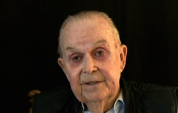6:47 | Marvin Dyer remember how his task force in the Pacific was used as "kamikaze bait" to draw out Japanese aircraft throughout the numerous small Pacific islands.

Marvin Dyer describes a defensive trick that German U-boats would pull during combat with the Allies during World War II.
Marvin Dyer remembers the dangers that naval convoys faced from both Germans and the weather in the North Atlantic.
Marvin Dyer talks about the damage he saw at Pearl Harbor when he arrived there a few days after the Japanese attack.
Even before the Pearl Harbor attack, Marvin Dyer talks about how the U.S. would have inevitably joined the war effort against the Axis powers during World War II.
Stationed on the destroyer USS Hammann, Marvin Dyer describes what life was like on a ship in the Pacific.
Marvin Dyer recalls his ship's role in the Battle of the Coral Sea in May of 1942, including rescuing crewmembers from the USS Lexington after a Japanese bombing run.
After decoding Japanese messages regarding an attack on the area, Marvin Dyer describes his ship's involvement in the Battle of Midway in June of 1942, during which his ship was destroyed by a torpedo.
After suffering casualties during the Battle of Midway, Marvin Dyer describes how fallen sailors were buried at sea on the way back to Pearl Harbor.
Marvin Dyer remember how his task force in the Pacific was used as "kamikaze bait" to draw out Japanese aircraft throughout the numerous small Pacific islands.
Marvin Dyer describes how "picket ships" such as his were used to make radar sweeps looking for Soviet aircraft during the Cold War.
During Operation Sandstone, Marvin Dyer talks about patrolling the test areas and witnessing nuclear explosions on the small island of Enewetak in 1948.